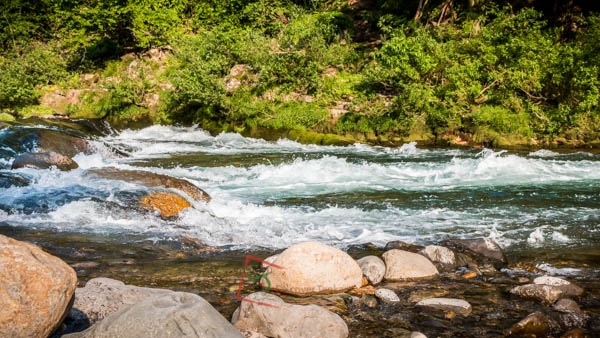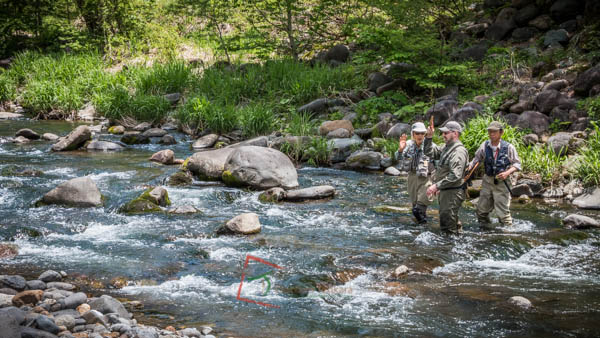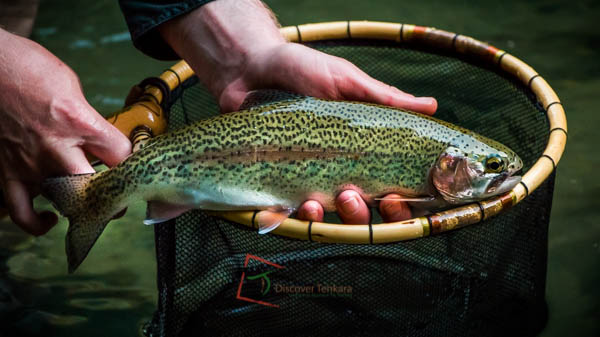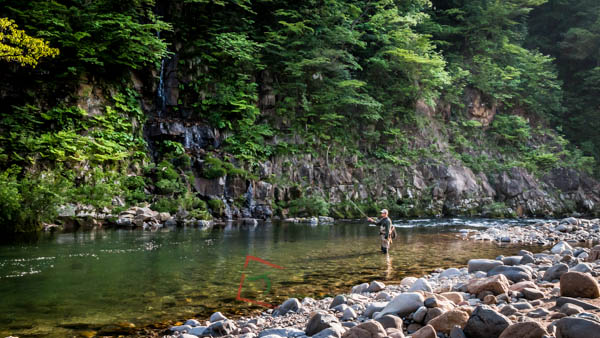
One of the most interesting things that we can pass on from our trip is that, to date, pretty much all of the information that the west has heard about tenkara from Japan would come under the banner of “Keiryu tenkara”. But in recent years, “Honryu Tenkara” is becoming better known. First, though, we need to define what the regular “Keiryu” tenkara is like..
Put simply, keiryu tenkara refers to the suite of tenkara skills that has been developed for fishing the slightly smaller tributary streams of mountain river systems – which are known as “Keiryu”.
This is, actually, probably a really good thing – as we would argue that you really need to have a lot of these skills down solidly (and to understand the rationale that underpins those techniques) – before moving on to the diverse modifications. Otherwise, there is no “road map” through all the different tweaks and variations – it just appears to be a mass of random variants with every different option being entirely equivalent in efficacy.
As with any modification to a technique, there are trade-offs (both in efficacy AND aesthetic preference!) to be made between different options. For each angler, there will always be one optimal compromise for each different angling challenge between precisely what you lose on the swings and what you gain on the roundabouts…
Honryu Tenkara on the Rise

Within approximately the last 15 years or so, Japanese anglers have begun to develop modified approaches to fishing “Honryu” or “main streams” found in mountain areas. These rivers can be very wide, steep with deep pools, massive boulders and some awesomely powerful currents. In fact, in the USA and UK, “Honryu tenkara” is designed for precisely the kind of rivers that many rod and reel fly fishers state are “impossible to fish using tenkara gear”.
I am sure that we will produce another blog post soon to help communicate that there will be many more rivers than most people think that are highly susceptible to the appropriate tenkara-based approach! The latter part of this blog post will start to break down some of the “sub-categories” within Honryu tenkara approaches – but first of all we need to talk about some of the details of Keiryu tenkara…
Keiryu introduction

Much like the need to properly understand “distance” and a solid defensive “guard” in boxing if you are to avoid frustration/bruises , you will really struggle to progress in tenkara without a great grounding in the fundamental skill-set found in good Keiryu tenkara.
The crucial epiphany here is that each “rule of thumb” (and then each subsequent “plan B” or caveat to cope with varying conditions) all START WITH THE FISH and then derive a designed technical solution from there. So, the “fly first cast” and “don’t allow the casting line to touch down during the drift” tenets come from a desire to have the fish see only the fly – which it hopefully wants to eat!!
All of fly fishing relies on triggering off a fish’s feeding reflex WHILST simultaneously avoiding tripping its fight or flight response. By landing the fly too heavily – or landing the casting line on the water; you are much more likely to trigger a flight response than a feeding response. Additionally, the line held aloft makes unnatural drag a cinch to manage! The same rationale of “give them food not a fright!” is the reason for the (generally) very short drifts of around 3 to 5 seconds.
This avoids having shadows of the thick, distracting, casting line and/or rod tip sweep over the heads of the majority of the fish in a pool before those fish have seen the fly. Typically you won’t see the fish that you would have otherwise caught if you’d used 4 or 5 times as many short – but perfect – drifts in the right sequence; you just won’t catch them (and consequently it is really difficult to learn that they are there to be caught with the right approach!! ☺). Pick off the back markers with short contained drifts, and you’ll still have plenty of fish to go at as you move up the pool.
Keiryu Tenkara is Built on “Fly First” Casting
The fly first cast/line aloft approach (especially when coupled with a fly with a nice “anchoring” hackle) also allows you to more easily “surf” the various eddies and currents in order to hold your fly in certain hot spots in the stream. In fact, taken together, these simple tenets all help to produce that nice effect of showing a fish something it might like to eat before you’ve scared the living crap out of it (which – it turns out – makes them “a bit more difficult to catch”!).
It is also the reason that the following are really BAD IDEAS if you have access to a long rod, light level line and some stream craft (and you want to stand a good chance of catching several fish). So DON’T LET ME CATCH YOU:
- Using cut down fly line or even overly-heavy level fluorocarbon/furled line to cast with (working a little on your casting stroke would be way more effective)
- Laying the long rod low to the water when it isn’t 100% necessary (removes the ability to avoid drag, dulls the hook-set, spooks fish by lining them, spooks the whole pool when you try to set the hook on a fish and ziiiiiiiiiiiiip!! the line off the water)
- Casting up/across stream towards the head of the pool and tracking a long sweeping drift down over the fish (spooks fish with the line and rod overhead)
- Leaving drifts on the water longer than absolutely necessary (spooks fish with the line and rod overhead/quality of dead drift tends to reduce as time goes on and drag sets in)
Roughly constant features of keiryu tenkara:
- Unweighted, simple flies
- Fly first casts/only tippet in the water (as little tippet as possible to fish at the required depth)
- High rod tip/ALL casting line held off the water (unless for certain vigorous downstream or across stream manipulations where it might be necessary to anchor some line in the water to stop the fly being jerked out through the surface)
- Tippet lengths typically between 50cm and 1m long
- Casting lines that are as light as the angler can manage effectively

Great keiryu tenkara anglers know exactly where the specific type of fish will be in the stream AND exactly where the best place to cast from will be (when taking wind, sun and water-flow into account at that exact moment in time). They will also know how quickly the fly should be moving to be most attractive to those fish on the day. In other words – they know the habits of the fish of their rivers inside and out. It is worth highlighting that, for the original subsistence/professional tenkara anglers – modern “keiryu tenkara” bears the greatest stylistic resemblance to how they caught fish to survive.
A note on the Ishigaki “One fly” message misinterpretation
Most tenkara nuts have heard about the “one fly” approach – and it can be a great thing to challenge your skills with. However, some of the message seems (potentially) to have been slightly lost in translation. What Dr. Ishigaki is keen to impress on people (and he certainly proved it on the rich, limestone/famously “hatch-driven” Derbyshire river we took him to in England) is that
“Even a simple scruffy fly can be devastatingly effective when it is the right size and includes a handful of simple prey image trigger features”.
Furthermore, fly PATTERN selection (particularly in pocket water) comes quite a long way down the list of reasons that you might not be catching fish! There are so many things that you can change with regard to angle of approach, movement of the fly (both passive and active), size of the fly that are often far more important.
In other words, for people wanting to improve in fly fishing – there is a lot of merit in avoiding the paralysing neurosis that “I must have the wrong fly on – and I don’t have the right fly in my box”. Finally, when an angler gets to the point that they realise – from observing fish behaviour for instance – that a certain feature of a fly (e.g. its propensity to sink or to behave in a certain way in the water) is likely to be important; they can make those choices in an informed manner, instead of the frantic, random changes of someone paralysed by indecision. It is a very typical Japanese approach to give a solid and simple rule that will serve a pupil really well – right up to the point that they outgrow it.
That doesn’t mean (in ANY way) that settling on a few sizes of just one or two “confidence” patterns and using angling skill to change what they imitate is restricted to a beginner’s approach! It is both a really fun challenge that focusses on fishing skills and stream craft – and incredibly effective in the right hands. Amano-sensei, for instance, doesn’t bother changing the size of hook for flies of different size – he just changes hackle diameter. Similarly, for keiryu tenkara, Dr. Ishigaki tends to fish with his flies made with a sewing thread body, no rib and either a soft hackle for “sasoi” (manipulated) presentations in slow water whilst the rest of the time favouring cock hackle for dead drift, anchored (tome-zuri) and various manipulations on and beneath the surface in all types of water. For Dr. Ishigaki’s honryu tenkara – fly pattern can sometimes be a different matter altogether…
Honryu Tenkara
So, now we come to the distinct arm of techniques that are applied to honryu streams. Of course, it is possible (but probably unnecessary) to apply these techniques in smaller streams too. However, the unavoidable trade-offs will tend to mean that standard keiryu tenkara approaches will generally be the better option. There are two further (and pretty obvious) subdivisions within “honryu tenkara” itself and we will cover these in the next sections. First of all, though, it will be helpful to lay out the general features that you tend to find across all Honryu tenkara:
- Rods are typically in the 4.5 to 5-m long range
- The favoured rods are surprisingly light and will tend to be able to cast lighter lines (in the #2.5 range) as well as coping with heavier lines (typically up to around #4 level line) and heavier fish in powerful flows
- Typical casting lines are between 5.5m and up to 12m long
- Fly-first (long) casts are made and as much of the line is held off the water as possible
- Manipulation tends to be commonly applied to the flies via the rod-tip (although lighter lines may also utilise water and wind-current “surfing” to control a fly close to/on the surface)
- Tippets in the 1 to 1.5m long range (occasionally up to 2m)
- The majority (and sometimes all) of the casting line can be held aloft over powerful currents – allowing the fly to be presented or manipulated in the slower pockets and back-eddies beyond
- As for keiryu tenkara – single flies are used on a cast (no droppers)
Now for the main dividing lines for honryu techniques…
Unweighted/traditional design kebari school (an elite advocate of which is Masami Sakakibara)
Here, the game- or challenge – is focused on how to either use stream currents to control the depth of the fly – or to combine mobile flies (sometimes of larger size) with a variety of active manipulation techniques to draw the fish up to strike at the fly. Fluorocarbon level-lines are commonly used and all the top tenkara anglers that we met recommended fluorocarbon over nylon for lines up to around 8 (or perhaps 10) metres long – especially for beginners and improvers in both keiryu and honryu tenkara.
However, for the super long lines in the 10-m to 12-m range; Masami makes a (highly specialist) exception and uses tapered nylon lines. The reason for this is that, because he deliberately restricts his tenkara to unweighted flies, the more buoyant nylon (which at those lengths and tapers must always fish with some of the casting line laying in the water) retains a more direct “contact” with the fly.
This is due to the fact that it will fish at a more similar depth to the unweighted fly (compared to the denser fluorocarbon) and also because it is easier to lift it clear of the water on the hook-set. In addition, the necessity to allow casting line to touch the water results in the use of longer tippets than those seen in keiryu tenkara.
Shorter tippet gives improved accuracy and control of the kebari in keiryu settings; longer tippets give greater separation between the kebari and the distraction of the comparatively bulky casting line. This style of fishing retains more of the features of traditional keiryu tenkara and it majors on developing elite skills in casting, kebari control, stream craft and the ability to coax strikes out of fish using a broad array of manipulations.
It is very technically focused. Masami and other like-minded practitioners are uncomfortable with the use of additional weight in the form of bead-heads or even extra heavy-gauge wire hooks under the banner of “tenkara”. We are drawn to the exploration of technique within these parameters and will strive to improve our abilities as much as we can under this paradigm (it is our preferred – but not exclusive – practice). But we are also conversant with and enjoy catching fish under the alternative branch of honryu tenkara techniques as well…
Bead-head and non-traditional kebari honryu tenkara
We were very honoured to receive a private day’s tuition with Dr. Ishigaki in his honryu tenkara approach. We were also phenomenally fortunate to spend many days fishing and talking with Saigo-san (a truly exceptional angler) who has probably the most consistently effective honryu tenkara skills out of anyone that we personally saw in Japan.
Both Saigo-san and Ishigaki-sensei use tungsten bead-head kebari for their honryu tenkara. Both also incorporate features like fluorescent hot-spots of dubbing behind the bead in their honryu kebari. The subtleties lie (as ever) in tuning in to fish behaviour and then accommodating the challenges posed by the big, powerful river setting in getting a fly in front of those fish in a controlled manner.
Unweighted flies and gossamer light lines held off the water right up to the eye of the kebari may be compulsory for success in some scenarios. In other situations, 2.5 to 4-mm diameter tungsten bead heads cast on fluorocarbon level lines and “pulsed” rhythmically through likely deep pockets/runs, current seams and large back-eddies after being allowed to sink whilst tracked with the rod tip might be the medicine! Casts and manipulations may be made at all angles to the current and, where possible, most or all of the casting line is held or pulsed clear of the water surface.
This improves take detection, minimises spooking and maximises ability to set the hook. The longer tippet allows the fly to fish at increased depth and also extends the separation between coloured casting line and kebari (to avoid spooking/distracting a fish that is chasing the kebari).
Of course, the current text introduction can only skim the surface of the required (and fascinating) detail of all these techniques – and we hope to bring you as much detail as we can via direct tuition or DVD content as well as further blog posts and articles.
We hope, as a minimum, that the framework above gives at least a basic guide to what (to the uninitiated) could look like a whole mess of random variants. We have used as our yardstick the observation that each variant approach begins with a deep understanding of the fish and their interaction with natural and artificial prey items – as well as natural and “artificial” predators like anglers.
The variant approaches are subsequently designed to trigger off the former, whilst avoiding the latter circuitry in the fish’s nervous system! Experimentation within tenkara will be most effective when we understand – and play with – the various means to avoid detection under varying circumstances whilst optimising how the fish perceives our artificial offerings. There are tons of different ways to skin a cat, but only a relatively small subset will approach a truly optimal solution. Seeking these “optimals” is a fabulous addiction…
It is brilliant to think that we are only just getting the gift-wrap off this strange gift from Japan called tenkara. We have a huge amount to learn from the masters who have such a big head start on us…and what a joy to be able to obsess over closing that gap as part of a global community of tenkara addicts!! Here’s to the journey…☺ ☺
